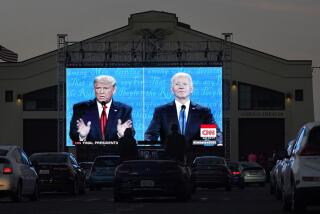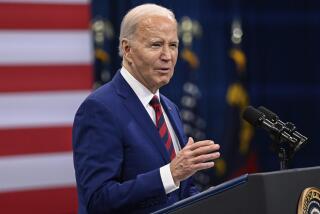Obama delivers a confrontational State of the Union address
Reporting from Washington — By using his State of the Union speech to draw sharp contrasts with Republicans on such high-profile issues as taxes and the housing market, President Obama opened an election-year debate on the role of government that could be more intense than any in decades.
Warning Congress that “I intend to fight obstruction with action,” he painted a confrontational picture that stands in sharp contrast with the conciliatory approach taken by the last Democrat to seek a second term, Bill Clinton.
In fact, Obama’s strategy more closely resembles that ofGeorge W. Bushin 2004, who used polarizing issues to increase turnout of his supporters and made few concessions to the center. The approach increases the chance that if he wins a second term, Obama could claim a mandate for his program. It also carries more risk of failure in a nation still deeply skeptical of government activism.
PHOTOS: Obama’s State of the Union address
Only a few months ago, many voters had seemed on the verge of writing Obama off. But in recent weeks, two developments have given him a chance to ask those voters for another look. One is the economy, which has started to show signs of improvement — declining unemployment, rising consumer confidence and reduced levels of household debt. The other is the way the Republican primary race recently has focused on the vast wealth (and relatively low tax burden) of the party’s sometimes front-runner, Mitt Romney.
Obama drove straight at the wealth issue with the signature proposal of his speech: a minimum tax for millionaires that formed part of his call for all Americans to pay their “fair share.” The proposal, requiring people with incomes of more than $1 million to pay at least 30% in taxes, would conveniently — administration officials insist coincidentally — double the taxes that Romney paid last year, according to the tax return the former Massachusetts governor released earlier in the day.
Similarly, the speech’s other major domestic proposal — a plan to make mortgage refinancings more available to homeowners who owe more than their homes’ value — would insert the government more directly into the housing market.
Republicans have adamantly resisted higher taxes on those they term “job creators.” And they have called for the federal government to get out of the housing market entirely, saying that federal involvement has only made the country’s foreclosure crisis worse.
They also wasted no time in rejecting Obama’s basic premise about the conflicting interests of the middle class and America’s wealthiest citizens. “We do not accept that ours will ever be a nation of haves and have-nots; we must always be a nation of haves and soon-to-haves,” Indiana Gov. Mitch Daniels said in his Republican response. He accused Obama of “extremism” and called for lowering tax rates.
Like Clinton, Obama seeks reelection after a disorienting midterm defeat in which Republicans captured control of the House. Both Democrats delivered their election-year State of the Union speech after months of bruising confrontations with Congress in which they tried — with some success — to paint Republicans as extremists.
But Clinton sought to co-opt the GOP’s rhetoric, memorably declaring early in his address that “the era of big government is over.” And even as he used the power of his office to block many Republican efforts to roll back government, he largely set aside his own plans to expand its reach in such areas as healthcare. By blurring the contrast between himself and the GOP, Clinton made himself a frustratingly elusive target, but set up a campaign that avoided most major issues.
The difference between Obama’s approach and Clinton’s reflects the personalities of the two men, but also the times.
Clinton, for all the adulation he now receives from the left, entered national politics trying to break the hold that liberal interest groups had on his party and criticizing what he called the “brain-dead policies of both parties.” Obama, for all his professed desire to create a “post-partisan” political culture, comes from a notably more liberal tradition.
More importantly, the political center toward which Clinton tacked has eroded so much in 16 years that Obama probably could not follow Clinton’s model even if he wished to.
America’s political parties have grown more polarized. Democrats have moved somewhat to the left; Republicans have shifted many steps to the right, according to political scientists who have analyzed congressional votes, issues positions and polling data. Policy ideas that only a decade ago characterized the conservative side of major debates — a mandate that individuals buy health insurance in a regulated market, for example, or a “cap and trade” system to limit pollution — are now excoriated by Republicans.
Over the past year, in which he sought and failed to achieve a “grand bargain” with Republicans on the federal budget, Obama learned painfully just how little ground remains in the political center.
“Obama knows he has 44% of the electorate” to start with, and in a country as divided as the U.S., “44% is a big number,” said Peter Hart, the Democratic pollster. He’s decided “I’m going to keep those people on board, then we’ll go after everyone else.”
Getting the rest of the way to a majority depends on persuading a handful of crucial voters in the middle who find themselves tugged in two directions.
PHOTOS: Obama’s State of the Union address
On the one hand, voters — including those who call themselves independents — hold a deeply skeptical view of government and its ability to help them. Fewer than one-third of voters have a positive view of the size and power of the federal government, a share that has fallen steadily since the early years of Bush’s tenure, according to a series of Gallup polls.
At the same time, pollsters have found a sharp and rapid increase in the percentage of people who doubt the Republican idea that America has no class divisions. In 2009, a majority of both Republicans and independents said they saw little if any conflict between rich and poor, according to a survey by the Pew Research Center. Now, more than two-thirds of Americans, including those independent voters, say they think such conflicts are “strong” or “very strong.”
In the balance between that skepticism of government and the acknowledgment of class conflict, the 2012 election could be determined.
More to Read
Get the L.A. Times Politics newsletter
Deeply reported insights into legislation, politics and policy from Sacramento, Washington and beyond. In your inbox three times per week.
You may occasionally receive promotional content from the Los Angeles Times.











